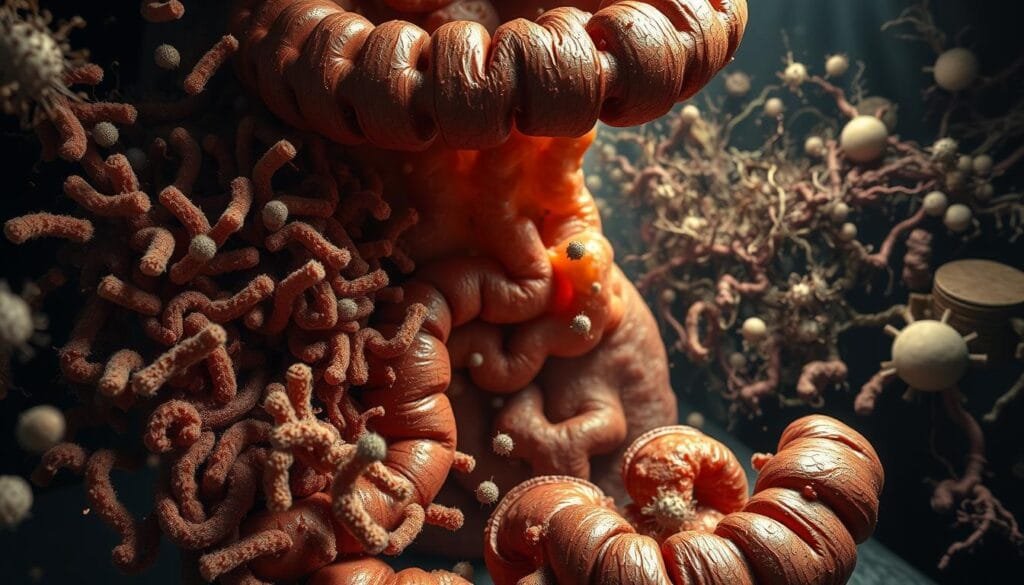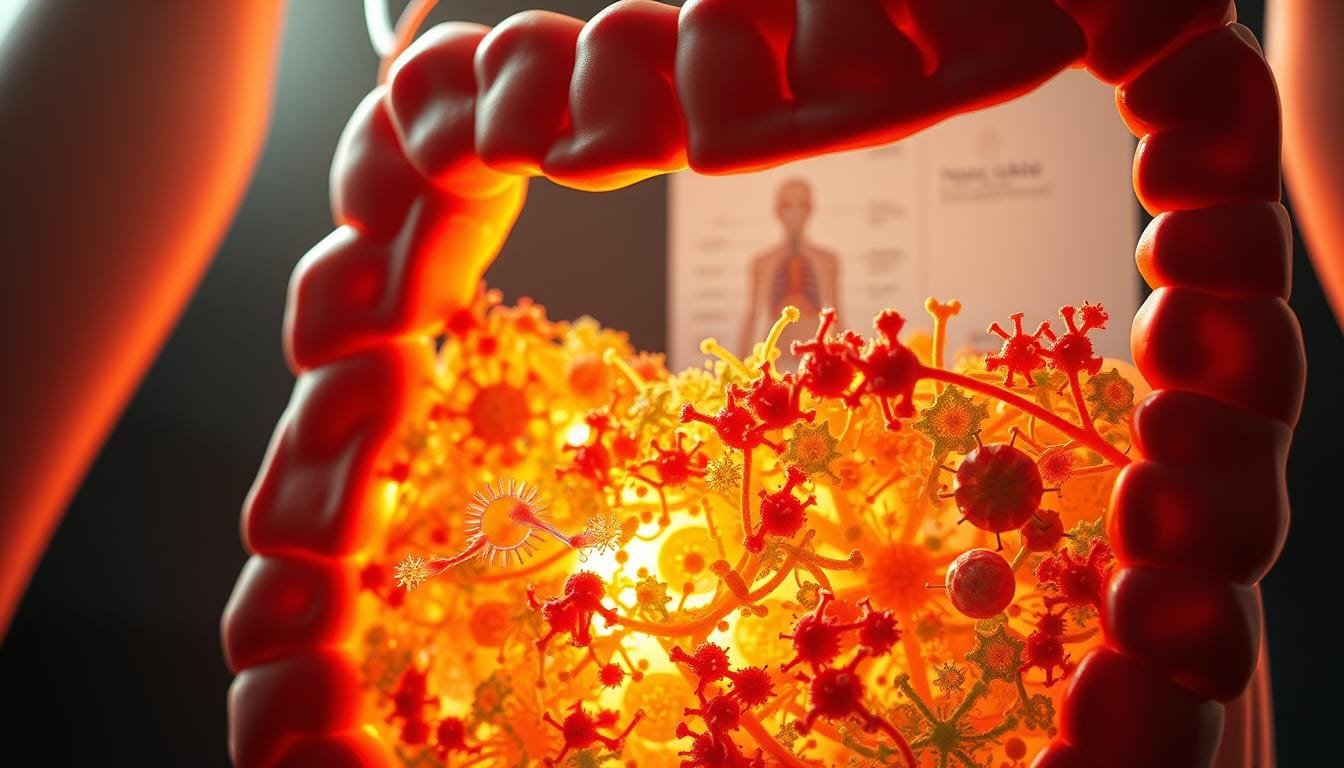Currently Empty: RM0.00
Your digestive system houses a bustling community of microscopic life that shapes your well-being in ways you might not expect. This complex ecosystem contains trillions of bacteria, fungi, and other organisms working together like a hidden organ. In fact, these tiny residents outnumber your human cells by about 10 to 1—a partnership that’s lasted your entire life.
This internal world doesn’t just help break down food. It produces essential nutrients, trains your immune system, and even communicates with your brain. The genes within these organisms vastly outnumber your own DNA, creating a living library that influences everything from energy levels to mood regulation.
Maintaining balance in this delicate system is crucial. Factors like diet, stress, and medications can shift the populations of helpful and harmful microbes. When properly nurtured, these organisms support digestion, fight infections, and contribute to maintaining a healthy weight.
Ready to explore how this invisible universe impacts your daily life? Let’s uncover the science behind your body’s microbial allies and learn practical ways to keep them thriving.
Key Takeaways
- Your digestive system hosts 40 trillion microbial cells—more than the human cells in your body
- These organisms act like a supporting organ, weighing 2-5 pounds in adults
- Microbial genes outnumber human genes by 100-to-1, influencing multiple body functions
- Balanced microbial populations aid digestion, immunity, and disease prevention
- Diet and lifestyle choices directly affect microbial diversity and health outcomes
Introduction to the Gut Microbiome
Deep within your body lies a thriving metropolis of microscopic allies. These tiny inhabitants form complex communities that shape how you process food, fight illnesses, and maintain energy levels.
Defining the Microbial Community
Your intestinal tract hosts over 1,000 types of microorganisms. Most gather in the cecum—a specialized pouch in the large intestine. This living network includes:
- Beneficial strains that break down fiber
- Immune-supporting organisms
- Chemical-producing species affecting mood
| Microbial Type | Key Role | Primary Location |
|---|---|---|
| Bacteria | Nutrient production | Large intestine |
| Viruses | Immune regulation | Small intestine |
| Fungi | Enzyme creation | Digestive tract |
Why This Ecosystem Matters
Your microbial partners begin colonizing at birth and adapt throughout life. Breastfeeding, environment, and even delivery method shape their diversity. A balanced community helps:
- Extract vitamins from food
- Neutralize harmful pathogens
- Support mental clarity
Research shows that maintaining this balance through targeted nutrition can improve digestive efficiency and immune responses. Simple dietary choices directly influence which microbes thrive—a partnership worth nurturing.
Gut Microbiome Explained: The Foundation of a Healthy You
Your intestinal tract hosts an extraordinary team of microscopic specialists. These bacterial partners handle tasks your body can’t manage alone, from vitamin production to immune defense. Two main groups dominate this ecosystem—Bacteroidetes and Firmicutes—working in harmony to keep your systems running smoothly.
Understanding Key Microbial Functions
Bacteroidetes excel at breaking down complex fibers, releasing nutrients locked in plant-based foods. Firmicutes help absorb these nutrients while producing short-chain fatty acids that strengthen intestinal walls. Together, they:
- Create essential vitamins like B12 and K2
- Convert indigestible compounds into usable energy
- Produce protective chemicals against harmful invaders
| Bacterial Group | Primary Function | Health Impact |
|---|---|---|
| Bacteroidetes | Fiber breakdown | Supports digestion |
| Firmicutes | Nutrient absorption | Boosts immunity |
The Role of Microbial Diversity
A varied bacterial population acts like an insurance policy for your health. Studies show people with diverse intestinal ecosystems tend to have:
- Stronger resistance to infections
- Better nutrient processing efficiency
- Lower inflammation markers
Simple choices like eating fermented foods or colorful vegetables help maintain this balance. Your dietary patterns directly influence which bacterial teams thrive—making every meal a chance to support your microscopic allies.
Key Functions of the Gut Microbiota
Trillions of tiny workers in your digestive tract perform jobs your body can’t handle alone. These microbial partners transform food into fuel, guard against invaders, and keep essential systems running smoothly. Their teamwork begins at birth and evolves with every meal you eat.
Digestive Health and Nutrient Absorption
Specialized bacteria break down tough plant fibers your stomach can’t digest. This process creates short-chain fatty acids that energize intestinal cells and strengthen the gut lining. These microbes also produce vitamin K and B vitamins your body needs for blood clotting and energy production.
Mineral absorption gets a boost too. Beneficial strains help extract calcium and magnesium from foods, making these nutrients more available for bone health and muscle function. Without this help, many vitamins and minerals would pass through undigested.
Support for the Immune System
Your intestinal microbes act as security guards for your body. They produce natural antibiotics that stop harmful pathogens from settling in. Through constant communication with immune cells, they teach your defenses to recognize real threats while ignoring harmless substances.
Three key protective strategies stand out:
- Occupying space on intestinal walls to block invaders
- Consuming nutrients that harmful bacteria need
- Triggering immune responses against dangerous organisms
This partnership explains why nearly 70% of your immune cells reside in digestive tissues. A balanced microbial community means better protection against infections and fewer allergy triggers.
Factors Influencing Microbiome Diversity
Imagine your intestinal flora as a vibrant ecosystem where daily choices determine which species flourish. Like sunlight and rainfall shape a forest, multiple elements work together to maintain microbial balance. Let’s explore what strengthens or weakens this invisible network.

Environmental and Chemical Impacts
Modern life exposes your digestive system to unseen challenges. Antibiotics act like wildfires—eliminating harmful pathogens but also wiping out beneficial strains. Other medications create ripple effects:
- Acid reducers alter stomach pH levels
- Painkillers slow digestive motility
- Steroids disrupt bacterial communication
Environmental toxins add pressure. Alcohol dehydrates intestinal walls, while tobacco smoke introduces harmful compounds. Urban pollutants and pesticides linger in foods, creating hostile conditions for helpful organisms.
Lifestyle and Dietary Influences
Your fork is the most powerful tool for microbial health. Eating 30+ plant varieties weekly feeds different bacterial groups. Try these simple swaps:
- Replace sugary snacks with colorful berries
- Choose whole grains over refined flour
- Add kimchi or tempeh to meals
Movement matters too. Regular exercise increases microbial diversity by 20-40% in studies. Consistent sleep patterns and stress management techniques like deep breathing help maintain stable conditions for bacterial colonies.
Diet, Nutrients, and Probiotics: Fuel for a Healthy Gut
Your plate holds the key to nurturing your body’s microscopic allies. Eating colorful fruits, crunchy vegetables, and fermented staples creates ideal conditions for digestive harmony. These choices deliver fiber, prebiotics, and live cultures that work together like nature’s maintenance crew.
The Importance of Fiber and Prebiotics
Plant-based foods act as premium fuel for beneficial bacteria. Legumes and berries contain soluble fibers that feed Bifidobacteria—key players in nutrient absorption. Prebiotic-rich options like bananas and oats go further, stimulating growth of these helpful strains.
Try mixing Malaysian favorites into meals:
- Swap white rice with barley in soups
- Add young jackfruit to curries
- Snack on local guava or mangosteen
Benefits of Fermented Foods and Probiotics
Traditional ferments like tapai (fermented rice) and tempoyak (durian paste) introduce Lactobacilli—bacteria that crowd out harmful species. Pairing these with kimchi or yogurt creates a powerhouse combo:
| Food Type | Key Bacteria | Local Example |
|---|---|---|
| Dairy ferments | Lactobacillus | Yogurt |
| Vegetable ferments | Leuconostoc | Pickled mustard greens |
For best results, combine prebiotic-rich foods with probiotic sources. A breakfast of oats topped with live-culture yogurt feeds existing bacteria while adding new reinforcements—a winning strategy for digestive vitality.
Dysbiosis and Its Impact on Health

Hidden within your intestinal tract, a delicate balance determines whether microscopic residents protect or undermine your well-being. When this equilibrium falters, harmful organisms can outnumber helpful ones—a condition healthcare professionals call dysbiosis.
Causes and Indicators of Dysbiosis
Modern lifestyles often disrupt microbial harmony. Antibiotics wipe out both harmful and beneficial bacteria, while chronic stress alters digestive conditions. Diets heavy in processed foods starve good microbes while feeding problematic ones.
Watch for these warning signs:
- Persistent bloating after meals
- Unexplained abdominal cramps
- Alternating diarrhea and constipation
Related Health Conditions and Symptoms
Research links long-term gut dysbiosis to serious disease risks. Irritable bowel syndrome sufferers often show reduced microbial diversity. Studies also connect imbalanced flora to weight management struggles and blood sugar irregularities.
This imbalance creates a vicious cycle—inflammation damages intestinal walls, allowing harmful substances into the bloodstream. Over time, this may contribute to mood disorders through the gut-brain network. Simple dietary adjustments and stress reduction techniques often help restore balance before major health issues develop.
FAQ
What exactly is the gut microbiome?
It refers to the trillions of bacteria, viruses, and fungi living in the large intestine. These microbes help break down food, produce vitamins like B12, and communicate with the nervous system to influence mood and digestion.
How does microbial diversity affect well-being?
A diverse mix of species strengthens resilience against pathogens, improves nutrient absorption, and reduces risks of chronic conditions like obesity or type 2 diabetes. Low diversity is often linked to inflammation and irritable bowel syndrome.
Can diet improve bacterial balance?
Yes! Fiber-rich foods like oats and apples feed beneficial bacteria, while fermented items like yogurt or kimchi add live cultures. Prebiotics (found in garlic or bananas) and probiotics work together to support a thriving microbial community.
What causes dysbiosis, and how is it detected?
Antibiotics, stress, or high-sugar diets can disrupt bacterial harmony. Symptoms like bloating, fatigue, or frequent infections may signal imbalance. Tests analyzing stool samples can identify specific microbial patterns tied to health issues.
Why does the microbiome matter for immunity?
Nearly 70% of immune cells reside near the intestines. Beneficial microbes train these cells to distinguish threats from harmless substances, reducing autoimmune reactions. They also produce compounds that fight harmful pathogens.
Are mental health and gut bacteria connected?
Research shows certain species produce neurotransmitters like serotonin. Imbalances may contribute to anxiety or depression through the gut-brain axis. This bidirectional communication impacts stress responses and cognitive function.
How do environmental toxins harm intestinal flora?
Pesticides, artificial sweeteners, and pollution can reduce beneficial bacteria while allowing harmful strains to thrive. This shift may weaken the gut lining, increasing permeability (“leaky gut”) and triggering inflammation.


